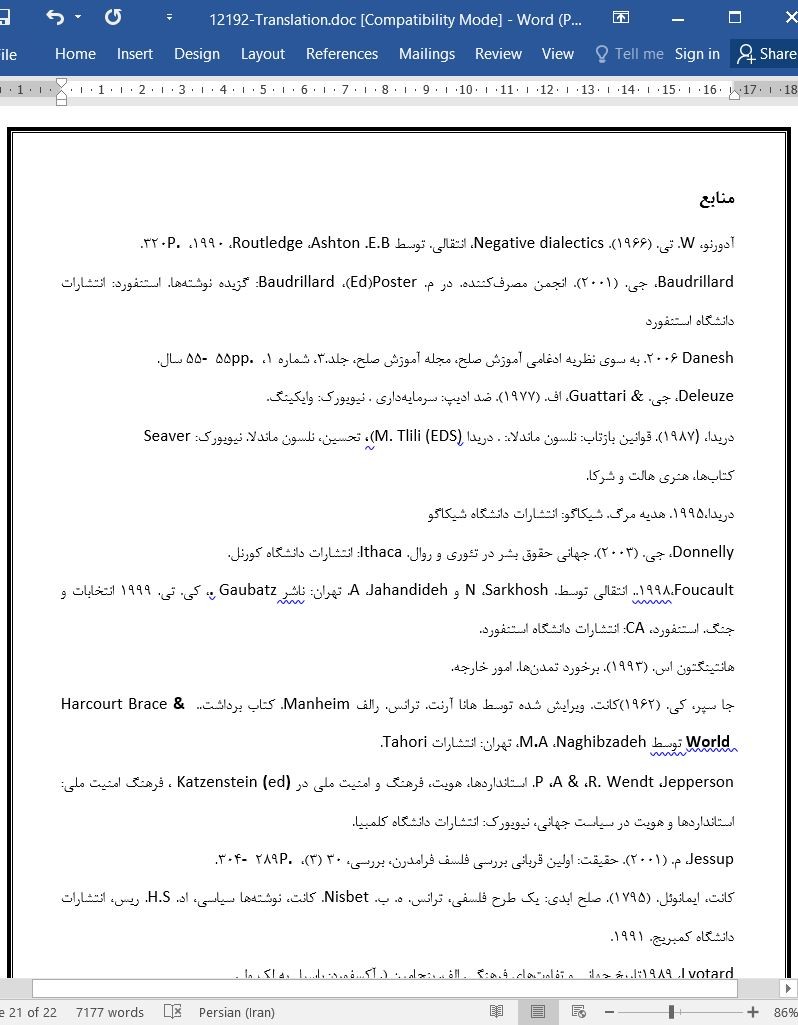
برنامه آموزشی مبتنی بر صلح بر اساس نظریه های تفاوت و شباهت
چکیده
بعد از برنامهدرسی لیبرال، بیشتر برنامههای آموزشی مبتنی بر صلح بر همگرایی، اتحاد و تشابه تاکید دارند؛ با این حال درک تفاوت میتواند به عنوان منبعی از برنامههای درسی مبتنی بر صلح به کار رود. با اینکه تفاوت ها ممکن است علت درگیری باشد، اما با توجه به درک و همدردی، به فرصتها برای ارتقای یکدیگر تبدیل خواهند شد. تفاوتها نیز باعث افزایش ظرفیت انسان و ایجاد زیباییشناسی خواهند شد. هدف این مقاله اثبات این موضوع است که برای تدوین یک برنامه آموزشی مبتنی بر صلح، استفاده از هر دو نظریه پستمدرن (که بر تفاوتها تاکید میکند)و نظریههای لیبرال (که بر شباهتها توجه دارند)به طور همزمان با هم، امکان پذیر است.
۱. مقدمه
از زمان تقسیم دیوار برلین در سال ۱۹۸۹، سرمایه داری و meta کمونیست از بین رفتند. با وجود نظریههای پستمدرن و فرا مدرن، meta جدید به وجود آمد. برخورد تمدن توسط سامویل هانتینگتون (۱۹۹۳)با meta تازه متولد شده مرتبط است. همزمانی با پیدایش meta، دلایل جنگ را پیچیدهتر و چند برابر کرده است . از آنجا که دلایل مختلف منجر به جنگ خواهد شد، دلایل مختلفی منجر به صلح خواهد شد. جنگ در کوهستان Turabura، افغانستان، از جنگ بوسنی و هرزگوین یا جنگهای اخیر متفاوت است؛ لازم است نتیجه ی برنامه آموزشی مبتنی بر صلح، عوامل کنترل بحران و جلوگیری از خشونت را در بر گیرد. درک ماهیت تعارض و صلح برای دانش آموزان بسیار مهم است. موضوعاتی مانند صلح و خانواده، صلح و حکومت، صلح و محیط، صلح و هنر، صلح و انسانیت، صلح و احساسات انسانی ، صلح و رسانه و صلح و امنیت و جامعه جهانی به همان میزان مهم هستند.
۸. نتیجهگیری
موضوع متا توسط فرامدرن قبول نمی شود ، میتوان گفت که در زمان ما صلح یکی از ضروریات زندگی بشر است. از آنجا که نابودی بشریت توسط جنگهای اتمی ممکن است، و نه محققان فرامدرن صلح را از بین میبرند، نه روشنفکران کلاسیک و مدرن میتوانند صلح دموکرات و ارتقا حکومت دولتی را در نظر بگیرند. اتحادیهها هدفمند در برنامهدرسی باید برنامهدرسی c را برای رسیدن به صلح در نظر بگیرند. نظارت داخلی باید بر اساس محیط کاربر و مشارکت آن ها صورت پذیرد. براساس نظریههای "تفاوت" و "تشابه" در برنامهدرسی صلح، ما به کثرتگرایی و جهان گرایی نیاز داریم. در یک برنامه آموزشی مبتنی بر صلح، اشاره به تفاوتها به اندازه ذکر شباهت ها مهم است. بنابراین مکانیزم آنها مانند یک جفت بال برای ایجاد یک برنامهدرسی ایدهآل و تاثیرگذار است.
Abstract
Following Liberal Curriculum, most of the Peace-Based curricula emphasis on Convergence, Unity and Similarity; therewith the understanding of “difference” can be used as a source of the Peace-Based curricula. Although differences may be the cause of conflict and clash, but through cognizance and sympathy they will change into chances to enhance each other. Differences also will cause the rise of human capacity and the creation of aesthetics. This paper aims to prove that in order to codify a peace-based curriculum, it's possible to use both postmodern theories (which focus on differences) and liberal theories (which focus on similarities) simultaneously together.
1. Introduction
Since the division of the Berlin Wall in 1989, capitalist and communist meta-narrations were demolished. Despite the postmodern and liberal theories, new meta-narrations came into being. The Clash of Civilization by Samuel Huntington (1993) is dealing with the newborn meta-narrations. Coincidence with the emersion of meta-narrations, the reasons of war has become more complicated and multiplied. Since various reasons will lead to war, also various reasons will lead to peace. War in the Turabura Mountains, Afghanistan, is different from the Bosnia and Herzegovina War or other recent wars; as a result in the Peace-Based Curricula it is necessary to include the agents of controlling crisis and preventing violence. Understanding the nature of conflict and peace is so important for the students. Subjects like peace and family, peace and government, peace and environment, peace and art, peace and humanism, peace and human feelings, peace and media, peace and business, peace and security and peace and the World Society are important at the same level.
8. Conclusion
Not to b accepted as a meta-narration by postmodern, it can be said that in our time peace is one of the essentials of human life. Since the destruction human by nuclear wars is probable, nor can postmodern scholars deconstruct peace, neither classic and modern liberals can prospect the pacifism of democrats and the rise of governmental unions An . ontent of the curriculum should be the c ,based curriculum-To accomplish the peace .internalized supervision is needed based on the users environment and should be done by their participation. Based on the Theories of "Difference" and "Similarity" in peace curricula we need both pluralism and universalism.
In a peace-based curriculum, mentioning the differences is as important as mentioning similarities. Thus their mechanism is like a pair of wings to make an ideal and influential curriculum
چکیده
۱. مقدمه
۲. شرح مساله
۳. پرسشهای پژوهشی
۴. صلح فرامدرن و نظریه فروپاشی : نظریه تفاوت
۵. صلح لیبرال و صلح جهانی سازی : نظریه تشابه
۶. جدال نظریههای فرامدرن و لیبرال صلح
۷. چارچوب برنامهدرسی براساس نظریههای تفاوت و تشابه
۷.۱. مطالعه خشونت و نزاع
۷.۲. تغییرات از شباهت به تفاوت
۷.۳.تغییرات از تفاوت به شباهت
۷.۴. اشتراکات برنامهدرسی صلح
۸. نتیجهگیری
منابع
Abstract
1. Introduction
2. Problem Statement:
3. Research Questions
4. Postmodern Peace and the theory of fragmentation: The Theory of Difference
5. Liberal Peace and ‘Universalizing’ Peace: Theory of Similarity
6. Controversies of the Postmodern and Liberal Theories of Peace
7. The Frame of the Curriculum Based on the Theories of Difference and Similarity
7.1. Pedigreed study of violence and conflict
7.2. Movement from similarity toward difference
7.3. Movement from difference to similarity
8. Conclusion
References
- اصل مقاله انگلیسی با فرمت ورد (word) با قابلیت ویرایش
- ترجمه فارسی مقاله با فرمت ورد (word) با قابلیت ویرایش، بدون آرم سایت ای ترجمه
- ترجمه فارسی مقاله با فرمت pdf، بدون آرم سایت ای ترجمه



